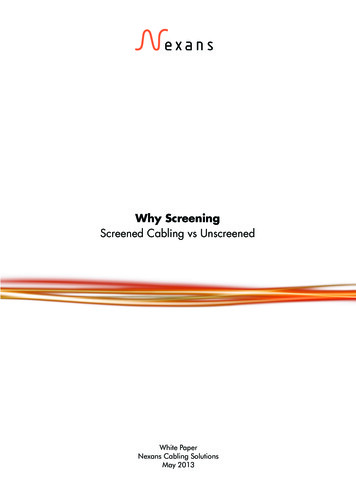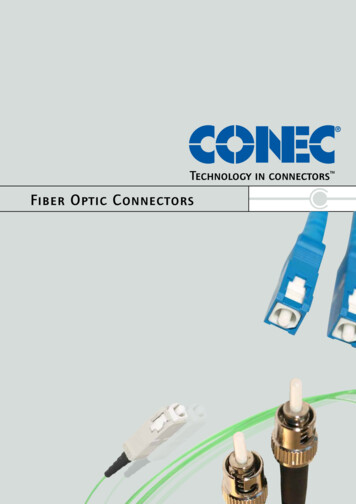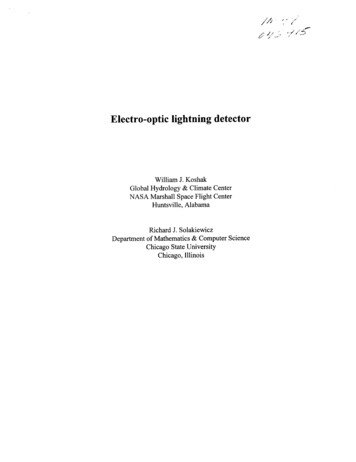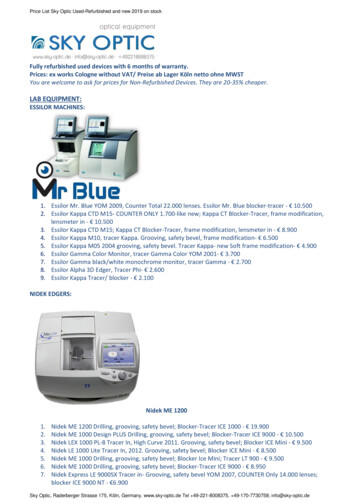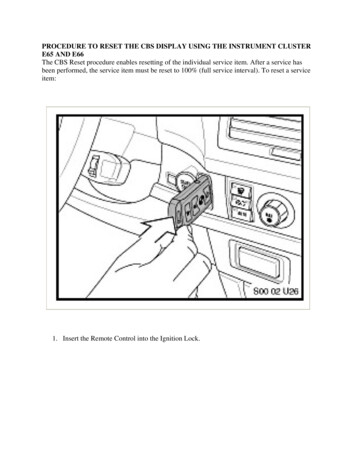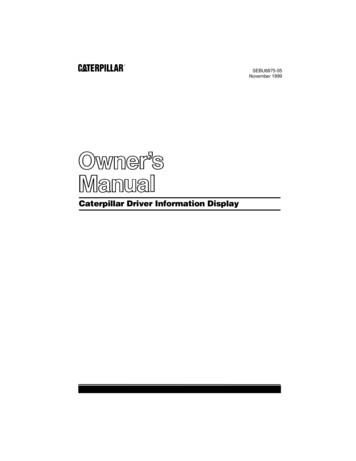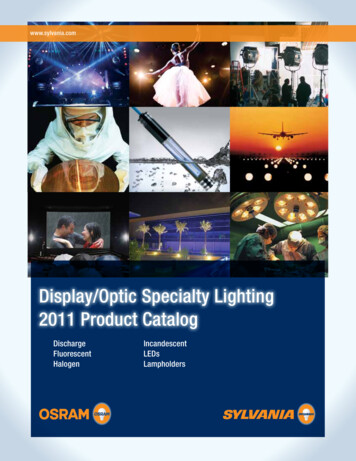
Transcription
www.sylvania.comDisplay/Optic Specialty Lighting2011 Product Lampholders
We wrotethe bookson innovativelightingsolutions.Our four new Product Catalogs provide specifications on more than 3000 SYLVANIA and OSRAMbranded products. All are designed and manufactured to the highest possible standards to bestsuit your lighting applications. And all are backed by OSRAM SYLVANIA, the industry leader inlighting solutions for over a century.www.sylvania.comTraditional Lighting2011 Product w.sylvania.comDisplay/Optic Specialty Lighting2011 Product CatalogSolid State LightingSpring 2011 Product sLampholdersLamp and Ballast Systems2011 Product CatalogFluorescentCompact Fluorescent Pin BaseHigh Intensity DischargeBallast and Controls
TABLE OF CONTENTSTABLE OF CONTENTSGlobal CareiiiInnovationivDisplay/Optic Markets ServedvGlossary of nt33LEDs34Lampholders (Stocked Types)36Symbols & Footnotes37Lamp Bases41Operating Positions44Warnings45Warranties54Index63Important NoticeThe OSRAM SYLVANIA Test and Measurement Laboratory is a participant in the Energy Efficient Lighting (EEL)Program of the National Voluntary Laboratory Accreditation Program (NVLAP-NIST) and is accredited for testingof lighting products according to the guidelines for the EEL Program. OSRAM SYLVANIA lamp and ballastmeasurements are conducted under laboratory conditions utilizing American National Standards Institute(ANSI), Canadian Standards Association (CSA), Commission Internationale de l’Eclairage (CIE), and IlluminatingEngineering Society of North America (IESNA) standards and practices. The OSRAM SYLVANIA ElectronicComponent and Systems Development Group participate in the Underwriters Laboratories Inc. Client Test DataProgram. Ballast designs are tested for conformance to Underwriters Laboratory (UL) safety standards usingpractices audited, assessed and approved by UL. Actual lamp and ballast performance may vary depending onapplication and environment (i.e. ambient temperature, input voltage, ballast type, etc.)The data and suggested applications contained in this catalog, as well as any additional information ourrepresentatives may be able to furnish, are for general information only and are not intended and should not betaken as representations or warranties as to the suitability of a lamp for any particular application or use in anyparticular equipment, nor are our representatives authorized to make any such representations or give any suchwarranties. Applications and conditions of use are many and varied and beyond our control. We do not have thesame degree of knowledge that the purchaser has with respect to the design of his equipment and the conditionsof its use. Therefore, it is up to the purchaser to make his own determination as to the suitability of a lamp for hisintended application or use and to assume responsibility for that determination.OSRAM SYLVANIA claims to supply the best possible products at all times. For this reason, OSRAM SYLVANIAreserves the right to make changes in its products when it believes such changes will improve its products.OSRAM SYLVANIA designs and manufactures lamps and ballasts to meet American National Standard Institutes(ANSI) and/or IEC (International Electrotechnical Commission) standards of construction and performance throughTotal Quality Manufacturing (TQM) practices where applicable. In addition, ballasts are designed and manufacturedto meet Underwriters Laboratory (UL) and Canadian Standards Association (CSA) safety standards as necessary.Ratings may change as a result of changes made to remain compliant with modified or updated standards.OSRAM SYLVANIA will release new or updated technical bulletins when appropriate. All product data presented inthis catalog supersedes all data published before 2/1/11.The specifications and information shown in this catalog are believed to be accurate. Although OSRAM SYLVANIAbelieves this information to be correct, no warranty is made or implied as to the accuracy of this information andOSRAM SYLVANIA does not accept or assume responsibility of liability for errors, changes, omissions, or for harmresulting therefrom.In accordance with our established policy to consistently improve our products, the specificationscontained herein are subject to change without notice.Many OSRAM SYLVANIA products listed in this catalog qualify under the North American Free Trade Agreement(NAFTA) as manufactured in Canada, the United States of America or Mexico.ii
Global CareThe Environment. Handle with Care.Global Care represents our comprehensive approach and commitment to social andenvironmental responsibility worldwide. As a leader in innovative lighting solutions, weare dedicated to developing products and processes that contribute to solving globalsustainability challenges, address energy efficiency and economic needs, and protect theenvironment today and into the future. Being a good neighbor – to our communities andto our environment – is a fundamental part of our business ethic at OSRAM SYLVANIA.Our Global Care commitment is realized through a variety of corporate initiatives: OSRAM SYLVANIA ECOLOGIC products areengineered to pass the Federal TCLP test forhazardous waste determination. Close to athousand of our products, the most in theindustry, proudly bear the ECOLOGIC mark. SYLVANIA Lighting Services sends more spentlamps to recyclers than any other lighting servicescompany in the United States. In 2006, we launched the Recycle Pak program,making it easier for our customers to recyclefluorescent lamps using pre-paid recycling kitsdelivered right to their door. For the tenth consecutive year, OSRAM SYLVANIAwas recognized in 2011 as an ENERGY STAR Partner of the Year. Nearly all SYLVANIA compactfluorescent lamps now carry the ENERGY STARlabel for energy efficiency.iii W e package many of our lamps in recycled andrecyclable materials, and use soy-based inks. Wereduce the amount of plastic packaging used wherepossible, and many of our lamps are packaged with100% recycled paperboard. Packaging and transportation and logistics efficienciesresult in significantly reduced cost-to-ship, fuelconsumption and overall environmental impact. We continually find ways to reduce or eliminatethe use of hazardous materials such as lead andmercury in our products.We’re proud of everything that we’ve accomplishedso far. But our job is far from done. OSRAM SYLVANIAis committed to continually finding innovative ways toprotect our environment and make our communitiesbetter places in which to live.
INnovationThe future of lighting is beingcreated today at OSRAM SYLVANIA.Leading you into the future of lightFor more than a century, OSRAM SYLVANIA has been a leaderin introducing products that deliver energy savings, reduceimpact on the environment and increase our customers’ bottomline. We have consistently refined and improved our traditionallighting technologies, while embracing the challenge to exploreand develop innovative products to meet future demands.Innovation drives profitable growthConsistently, over 40 percent of our worldwide sales resultfrom products that are less than five years old. Our R&Dfacilities in Massachusetts and Germany, which employmore than 1,400, are strategically located close to our globalproduction facilities. In addition, our global R&D team issupported by a corporate investment equal to 6.6 percentof sales.Follow a leader in lighting innovationOur innovative products are driven by unparalleled expertise inall facets of lighting science and technology, and by the highestlevels of customer support and service. Let us show you howlighting behaves, how it motivates, and how it influences ourlives and our performance. Most importantly, let us show youhow our experience in specification and application will ensureyou get the best performance and ROI from our products.Look to OSRAM SYLVANIA to provide tomorrow’s lightingsolutions for today’s lighting projects.iv
Display/optic marketsDisplay/Optic Markets ServedThe Display/Optic business group at OSRAM SYLVANIA offers an ever expanding rangeof OSRAM branded halogen, discharge, fluorescent and incandescent lamps, along witha variety of quality lampholders designed for high temperature lamps. We offer the mostinnovative LED solutions backed by global LED resources, including R&D (e.g. thermaland optical engineering; also for electronics and controls), projection management,manufacturing and quality assurance.With an expansive product portfolio, OSRAM offers state-of-the-art light sources for theEntertainment, Cinema, Display, Semiconductor, Industrial and Medical markets.SEMICONDUCTOR and INDUSTRIAL:High precision light illumination.MEDICAL:Light that helps doctors make diagnoses. Airfield/AircraftAir/Water Purification – GermicidalIntegrated Circuit ProductionIR HeatingLiquid Crystal Display (LCD) ProductionMaterial Technology and AgingOzone ProductionPaper Mill/Paper FinishingPET (polyethylene terephthalate ) Blow MoldingPhotopolymerisation (UV-Curing)Printed Circuit Board (PCB) ProductionPrinting IndustryRapid Thermal Processing (RTP)Wafer CleaningvAnimal BreedingBilirubin Medical TreatmentBoroscopyEndoscopyMicroscopyPhotodynamic Therapy (PDD/PDT)Surgical LightingUV Polymerisation (UV-Curing)Wellness & Therapy
AWARDS OSRAM was awarded two OSCARS for technical achievement from theAcademy of Motion Picture Arts and Sciences :1984 – for development of XBO xenon lamps used in cinema projection 1987 – for inventing and continuous improvement of HMI metal halidedischarge lamps used for television and film lighting 2007 – OSRAM was the recipient of the highly regarded 59th Primetime Emmy EngineeringAward in recognition of outstanding achievement in engineering development of HMI technologyPhoto: Academy of Motion Picture Arts and SciencesENTERTAINMENT:Turning light into a light show.DISPLAY:Creating light for images in all dimensions. Data and Video Projection Front and Rear Projection Architectural/Architainment LightingBlacklight IlluminationClub & Disco LightingExhibition LightingFilm and TV ProductionMicrofilm, Overhead, Video, Advertisingand Slide ProjectionPhoto FinishingPhotometryProfessional and Speed PhotographyReprographySolar SimulationSpotlights and Attraction LightingStage LightingTheater, Concerts, Studio, TVCINEMA:An impressive performance on screen. Cinema Digital and Film Projectionvi
GlossaryProduct Catalog Glossary of TermsAmpere A unit expressing the rate of flow ofelectric current.ANSI (American National Standards Institute) The organization that develops voluntaryguidelines and produces performance standardsfor the electrical and other industries.Audible Noise (Sound) All fluorescent lampballasts produce some noise. Most OSRAMSYLVANIA brand ballasts are sound rated A (upto 75% quieter than magnetic types) and acceptable for most applications. Care should be takenwhen mounting the ballast to reduce vibration.Average Rated Life An average rating, in hours,indicating when 50% of a large group of lampshave failed, when operated at nominal lampvoltage and current; manufacturers use 3 hoursper start for fluorescent lamps and 10 hours perstart for HID lamps when performing lamp lifetesting procedures; every lamp type has a uniquemortality curve that depicts its average rated life.For Display/Optic specialty lamps, average ratedlife refers to the operating period after which onstatistical average, 50% of the lamps will performwithin their specified values.Ballast A device used with an electric dischargelamp to obtain the necessary circuit conditions(voltage, current and waveform) for starting andoperating; all fluorescent and HID light sourcesrequire a ballast for proper operation. Dimmingballasts are special ballasts which, when usedtogether with a dimmer, will vary the light outputof a lamp. OSRAM Display/Optic dischargelamps are either designed for AC operation (sinewave and/or square wave with recommendedoperational frequencies below 1KHz) or DCoperation (current regulated or power regulated).Please see OSRAM lamp specifications for correct ballast or electronic control gear selection.Ballast Basics Ballasts have two primaryfunctions: 1) start the lamp and 2) control operationof the lamp once it has started. High frequencyelectronic ballasts operate lamps more efficientlyand eliminate the hum and visible flicker normallyassociated with standard magnetic ballasts.Electronic ballasts also typically have betterpower quality than magnetic ballasts.Ballast Life OSRAM SYLVANIA ballasts aredesigned to have an average life expectancy of60,000 hours. To maximize life, ambient temperature should be kept as low as possible. It is alsoimportant to maintain effective dissipation of heatusing the lighting fixture as a heat sink for theballast enclosure.Ballast Losses Power consumed by a ballastthat dissipates as heat instead of being convertedinto light. Electronic ballasts operate more efficiently than magnetic or hybrid ballasts. A typicalballast loss for a standard two lamp energysaving magnetic ballast is 12 watts, where anelectronic equivalent would only be 7 watts.Ballast Types There are three types of lightingballasts: 1) Magnetic: an inefficient device thatuses a core and coil assembly transformer toperform the minimum functions required tostart and operate the lamp; 2) Hybrid or “lowfrequency electronic”: essentially a magneticballast with a few electronic components thatswitch off voltage to the lamp coil once the lamphas started. A minimal increase in efficiency isobtained via more expensive magnetic corematerial and the absence of power to the lampcoils during operation; 3) High frequency electronic:a ballast that operates lamps at frequencies above20,000 Hz. Maximum efficiency is obtained throughthe use of electronic circuitry and optimum lampoperating characteristics.Base The lamp base mechanically holds thelamp in place in the application. The lamp basedirectly or indirectly (via a cable or lead-in wires)conducts electricity from the circuit to the lampand can be designed to dissipate heat. Lampbases should be operated within specifiedtemperature ranges.Beam Angle The angle between the twodirections for which the intensity (candlepower)is 50% of the maximum intensity as measuredin a plane through the nominal beam centerline(center beam candlepower).Color Temperature (CT) Color temperature,which is measured in degrees Kelvin (K), indicateswhether a lamp has a warm, midrange or coolcolor appearance. “Warm” light sources have alow color temperature (2000-3000K) and featuremore light in the red/orange/yellow range. Lightwith a higher color temperature ( 5000K) featuresmore blue light and is referred to as “cool.”Compact Fluorescent Lamps Compactfluorescent lamps employ small diameter tubesthat are bent so they begin and end in a singlebase. This allows them to be produced in a widevariety of configurations, greatly extending theapplications for fluorescent lighting.Current A measure of the rate of flow ofelectricity, expressed in amperes (A).Description (See Ordering Abbreviation.)Dimming Dimmable lighting systems weredeveloped originally to meet the need for lightingthat was easier on the eye. To an increasingextent, these systems are now also being usedfor cost saving reasons. Users can control thelighting with remote controls and switches, orcontrol circuits with daylight sensors can beused. Leading edge phase dimming is used forlow voltage tungsten halogen lamps operated withmagnetic transformers.Beam Spread In any plane the angle betweenthe two directions in the plane in which thecandle-power is equal to a stated percent of themaximum candlepower in the beam.Directional Lighting Illumination on the workplane or on an object predominantly from a singledirection.Black Body (Planckian Radiator) An idealvariety of technologies to meet the very preciselevels of performance required by the cinema,entertainment display, medical, science, industryand other high-tech fields.thermal radiator whose SPD curve is defined byits temperature in degrees Kelvin (K) and whosecolor coordinates lie exactly on the Planckian curve.Brightness (See Luminance.)Bulb Hard, soft or quartz glass enclosure, whichcan contain a vacuum, elemental inert gas ormetal and a means of light generation (filamentor electrodes).Candela (cd) The unit of measure indicating theluminous intensity (candlepower) of a light sourcein a specific direction; any given light source willhave many different intensities, depending uponthe direction considered.Candlepower Distribution A curve thatrepresents the variation in luminous intensity(expressed in candelas) in a plane through thelight center of a lamp or luminaire; each lamp orlamp/luminaire combination has a unique set ofcandlepower distributions that indicate how lightwill be spread.Center Beam Candlepower (CBCP) Theintensity of light produced at the center of areflector lamp beam, expressed in candelas.Chromaticity The aspect of color that includesconsideration of its dominant wavelength and purity.Color Rendering Index (CRI) The ColorRendering Index (CRI) measures the effect a lightsource has on the perceived color of objects andsurfaces. High CRI light makes virtually all colorslook natural and vibrant. Low CRI causes somecolors to appear washed out or even to take ona completely different hue.viiDisplay/Optic Specialty Lamps Employ aDouble-End Lamps that have two basesopposite one another for series electrical connection, mechanical mounting and heat dissipation.Electronic Control Systems (See Ballast.)EMI/RFI Electronic Ballasts contain circuitsthat limit electrical noise conducted onto thepower line or radiated through the air, otherwisereferred to as EMI/RFI. OSRAM SYLVANIAballasts comply with FCC 47 CFR Part 18,non-consumer limits for commercial applications.Ballasts for residential application must meetconsumer limits. OSRAM SYLVANIA has a complete line of magnetic ballasts for residential use.Filament A tungsten wire purposely positionedinside a lamp bulb, that when heated electricallygenerates radiation in the visible, infrared andultra-violet ranges. Tungsten material is mostoften used, as it has great tensile strength, is verydurable and can be heated very near its meltingpoint without evaporating rapidly. Lamp filamentsare offered in a variety of designs optimized forspecific applications.Fixture (See Luminaire.)Floodlight A reflector lamp with a relatively widebeam pattern. Also a luminaire consisting of lampand reflector at fixed distance providing a widefield of illumination.
GlossaryFluorescent Lamp A low pressure mercuryLamp Manufactured light source, synonymousFocal Distance The distance between a lampLamp Disposal When disposing of spent lamps,always consult federal, state, local and/or provincialhazardous waste disposal rules and regulationsto ensure proper disposal.vapor discharge light source. The electricdischarge generates ultra-violet (UV) energy,which is absorbed by a phosphor and convertedto visible light.(light producing element) and the focal point ofthe reflector surrounding it. Lamp alignment canbe adjusted to influence both illumination andcolor quality. Sometimes referred to as “workingdistance”.with light bulb; the three broad categories ofelectric lamps are incandescent, fluorescent andhigh-intensity discharge.Lamp Flicker Cyclic variation in output of a light1 lumen per square foot.source. High frequency electronic ballasts providea minimal level of lamp flicker. Lamp flicker frommagnetic ballasts may cause eye fatigue for somepeople.Frequency The number of times per secondLamp Fuse Wire or device designed to protectFootcandle (fc) A unit of illuminance equal tothat an alternating current system reversesfrom positive to negative and back to positive,expressed in cycles per second or hertz (Hz).Global Care Represents OSRAM SYLVANIA’scommitment to environmental and socialresponsibility.Halogen Lamps High pressure tungsten filamentlamps containing halogen gases. The halogengases allow the filaments to operate at higherefficacies than incandescent lamps. Halogenlamps also provide brighter, whiter light withbetter color characteristics, longer service lifeand improved energy efficiency.Harmonic An electrical frequency that is aninteger multiple of the fundamental frequency; forexample, if 60 Hz is the fundamental frequency,then 120 Hz is the second harmonic and 180 Hz isthe third harmonic. Some electronic devices, suchas ballasts or power supplies, can cause harmonicdistortion, directly affecting power quality.Hertz (Hz) A unit of frequency equal to one cycleper second; see frequency.High-Intensity Discharge (HID) LampsIn which an arc passing between two electrodesin a pressurized tube causes various metallicadditives to vaporize and release large amountsof light. All HID lamps offer outstanding energyefficiency and service life. Metal halide lamps alsooffer good to excellent color rendering index (CRI).Hot Ignition The restarting of a previouslyoperating lamp shortly after turn-off. Hotignition is a high performance feature in manyOSRAM SYLVANIA discharge lamp types.Illuminance Light arriving at a surface, expressedin lumens per unit area; 1 lumen per square footequals 1 footcandle, while 1 lumen per squaremeter equals 1 lux.Incandescent Lamp A light source using theprinciple of incandescence. When an electriccurrent passes through a filament wire (usuallytungsten), the heated wire glows. Filaments ofstandard incandescent lamps are enclosed in avacuum or gas-filled bulb. They provide low initialcost, good color rendition and excellent opticalcontrol.a lamp from over-voltage or over-current conditions. OSRAM requires that all Display/Opticlamps be fused in their applications to preventlamp over-powering. Certain lamps contain theirown internal fuse. Please ensure lamps in yourspecific application are fused with respect to theirpower source.Lamp Lumen Depreciation Factor (LLDF)The multiplier to be used in illumination calculationsto relate the initial rated output of light sources tothe anticipated minimum rated output based onthe relamping program to be used.LED A light-emitting diode (LED) is a semiconductorlight source used as indicator lamps in manydevices, and are increasingly used for lighting.Introduced as a practical electronic component inthe early 1960’s, early LEDs emitted low-intensityred light, but modern versions are availableacross the visible, ultraviolet and infrared wavelengths, with very high brightness.Lens A glass or plastic element used inluminaires to change the direction and controlthe distribution of light rays.Light Radiant energy that is capable of producing a visual sensation.Light Center Length (LCL) The distance froma specified reference point on a lamp base to itslight center.Light Loss Factor (LLF) A factor used incalculating illuminance after a given period oftime and under given conditions. It takes intoaccount temperature and voltage variations, dirtaccumulation on luminaire and room surfaces,lamp depreciation, maintenance proceduresand atmosphere conditions. Formerly calledmaintenance factor.LPW Performance Lumens per watt. Thenumber of lumens produced by a light sourcefor each watt of electrical power supplied to thelight source. Also see Luminous Efficacy.Lumens (lm) A unit of luminous flux; overalllight output; quantity of light, expressed in lumens.For example, a dinner candle provides about 12lumens and a 60-watt soft white incandescentlamp provides about 840 lumens.viiiLumen Depreciation The decrease in lumenoutput of a light source over time; every lamptype has a unique lumen depreciation curve(sometimes called a lumen maintenance curve)depicting the pattern of decreasing light output.See Lamp Lumen Depreciation Factor, LLDFand Mean Lumens.Luminaire A light fixture; the complete lightingunit, including lamp, reflector, ballast, socket,wiring, diffuser and housing.Luminaire Efficiency The ratio of luminous flux(lumens) emitted by a luminaire to that emitted bythe lamp or lamps used therein.Luminance (L) Unit of measurement: candelaper square meter [cd/m2]. Luminance ismeasured brightness of a light source on anilluminated surface.Luminance Contrast The relationship betweenthe luminances of an object and its immediatebackground (square feet or square meters).Luminance Ratio The ratio between theluminances of any two areas in the visual field.Luminous Efficacy The rate at which a lamp isable to convert power (watts) into light (lumens),expressed in lumens per watt (LPW or lm/W).See also LPW Performance.Luminous Intensity Unit of measurement:Candela (cd). A light source emits its luminousflux in different directions and different luminousintensities. Luminous Intensity is the luminousflux radiated in a particular direction.Lux (lx) A unit of illuminance equal to 1 lumenper square meter.Maximum Overall Length (MOL) The totallength of a lamp, from top of bulb to bottom of base.Mean Lumens Lumen output of a light sourceafter the source has been used. Mean lumenvalues for fluorescent and HID lamps are typicallymeasured at 40% of their rated lives. Most highpressure sodium and mercury lamps are measuredat 50% of their rated lives. All measurements aremade on ANSI reference ballasts. Mean lumensare not typically measured for incandescent andtungsten halogen lamps.Mean Spherical Candela (MSCD) The averagevalue of the luminous intensity of a light sourcein all directions. To convert MSCD to Lumens,multiply by 4p(12.57).Metal Halide Lamps Are high pressure mercurylamps with added metal iodides or iodides of therare earths dysprosium (Dy), holmium (Ho) andthulium (Tm) and complex compounds of cesium(Cs) and tin (Sn). They decompose in the core ofthe discharge arc and the metals can be excitedto emit light with an intensity and spectral distribution that depends on the vapor pressure of themetal halides. The luminous efficacy and the colorrendering properties of the mercury discharge aresignificantly improved as the gaps in the mercuryspectrum are filled by the spectral contribution ofthe other metals.
GlossaryNAED A five-digit number used to identify aspecific OSRAM SYLVANIA lamp. This NAEDnumber in this catalog is labeled Product Numberand should be used when ordering OSRAMSYLVANIA products. NAED is the abbreviationfor National Association of Electrical Distributors.Nanometer (nm) A unit of length equal to 109meters; commonly used as a unit of wavelength.Nominal Watts Wattage used to describe alamp. Also see Power and Watt.OFR Abbreviation for “ozone free” technology.Lamps with the designation OFR do not generateozone during operation.Operating Position Some lamps are specified/designed to be operated in certain positions, i.e.,horizontal or base up.Ordering Abbreviation Provides a shorthanddescription of the lamp, using a unique codewhich can be used when ordering a lamp if theProduct Number is not known. An example wouldbe: CF15EL/R30/830/MED, which translates toa15-watt Soft White DULUX EL reflector electronic self-ballasted compact fluorescent lamp withan R30 reflector, 82CRI, 3000K color temperatureand a medium screw base.PAR Lamps Pressed aluminized reflector lamp,with the outer bulb formed from two pressed glassparts that are fused or sealed together. PAR lampsmay be incandescent, halogen or HID types.Parallel vs. Series Wiring configurations forballasts. Ballasts with parallel lamp circuitry havethe benefit of companion lamps remaining lit,even if one of the lamps operated by the ballastshould fail. Systems with series lamp wiring(magnetic ballasts and many rapid start electronictypes) result in all lamps operated on the ballastgoing out if one should fail.Power The rate at which energy is taken from anelectrical system or dissipated by a load, expressedin watts (W); power that is generated by a utility istypically expressed in volt-amperes (VA).Power Factor A measure of the effectivenesswith which an electrical device converts voltamperes to watts; devices with power factors( 0.90) are “high power factor” devices.Preheat A class of fluorescents requiring astarter, which allows the lamp and filamentsto be properly heated before allowing the ballastto supply the correct current flow.Product Number (See NAED.)Programmed Rapid Start (PRS) A method ofstarting fluorescent lamps where cathode heat isapplied prior to lamp ignition, then removed orreduced once the lamp has ignited. PROStart ballasts maximize the number of lamp startingcycles while maintaining energy efficiency. This isthe preferred mode of lamp starting for applicationswith occupancy sensors and several on/off cyclesper day. Additionally, the lamps will strike reliablyin cold conditions down to 0 F.Rapid Start (RS) Rapid start ballasts apply a lowfilament voltage to preheat the cathodes. Simultaneously, a starting voltage (lower than that used ininstant start) is also applied to strike the arc. Whenthe cathodes are hot enough, the lamp will strike.The filament voltage continues to be appliedthroughout the operation of the lamp. Rapid startballasts appear to have a slight turn on delaycompared to instant start. They will typically notbe able to start lamps reliably under 50 F.Reference Ballast A ballast speciallyconstructed to have certain prescribed characteristics for use in testing electric-discharge lampsand other ballasts. Reference ballasts are typicallydefined by ANSI.Reflector A device used to redirect the light bythe process of reflection. Display/Optic reflectorlamps utilize ellipsoidal (converging light rays)or parabolic (collimating light rays) reflectors.Dichroic coated reflectors are designed to reflectvisible light and pass through unwanted
Incandescent LEDs Lampholders www.sylvania.com Lamp and Ballast Systems 2011 Product Catalog . Component and Systems Development Group participate in the Underwriters Laboratories Inc. Client Test Data Program. Ballast designs are tested for conformance to Underwriters Laboratory (UL) safety standards using


